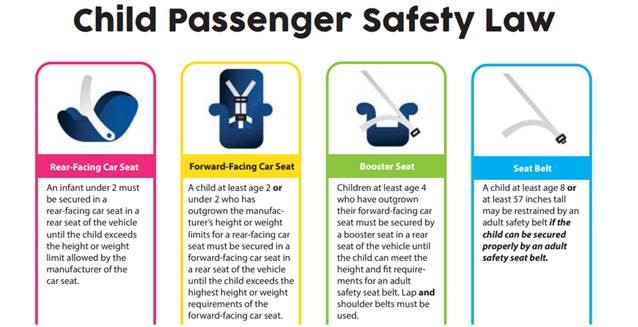
ARTICLE 47.
CHILD PASSENGER RESTRAINT SYSTEM
SECTION 1. Section 56-5-6410 of the 1976 Code is amended to read:
"Section 56-5-6410. (A) Every driver of a motor vehicle (passenger car, pickup truck, van, or recreational vehicle) operated on the highways and streets of this State when transporting a child under eight years of age upon the public streets and highways of the State must properly secure the child in the vehicle as follows:
- An infant or child under two years of age must be properly secured in a rear-facing 0exceeds the height or weight limit allowed by the manufacturer of the child passenger restraint system being used.
- A child at least two years of age or a child under two years of age who has outgrown his rear-facing child passenger restraint system must be secured in a forward-facing child passenger restraint system with a harness in a rear passenger seat of the vehicle until the child exceeds the highest height or weight requirements of the forward-facing child passenger restraint system.
- A child at least four years of age who has outgrown his forward-facing child passenger restraint system must be secured by a belt-positioning booster seat in a rear seat of the vehicle until he can meet the height and fit requirements for an adult safety seat belt as described in item (4). The belt-positioning booster seat must be used with both lap and shoulder belts. A booster seat must not be used with a lap belt alone.
- A child at least eight years of age or at least fifty-seven inches tall may be restrained by an adult safety seat belt if the child can be secured properly by an adult safety seat belt. A child is properly secured by an adult safety seat belt if:
- (a) the lap belt fits across the child's thighs and hips and not across the abdomen;
- (b) the shoulder belt crosses the center of the child's chest and not the neck; and
- (c) the child is able to sit with his back straight against the vehicle seat back cushion with his knees bent over the vehicle's seat edge without slouching.
- For medical reasons that are substantiated with written documentation from the child's physician, advanced nurse practitioner, or physician assistant, a child who is unable to be transported in a standard child passenger safety restraint system may be transported in a standard child passenger safety restraint system designed for his medical needs.
Any child restraint system of a type sufficient to meet the physical standards prescribed by the National Highway Traffic Safety Administration at the time of its manufacture is sufficient to meet the requirements of this article.
(B) For the purposes of this section, any portion of a recreational vehicle that is equipped with temporary living quarters shall be considered a rear passenger seat."
Vehicle child restraints, vehicles lacking rear passenger seats, rear seating capacity exceeded
SECTION 2. Section 56-5-6420 of the 1976 Code is amended to read:
"Section 56-5-6420. If a motor vehicle lacks a rear passenger seat or if all of its rear seating positions are occupied by children under eight years of age, a child under eight years of age may be transported in the front seat of the motor vehicle if the child is secured properly in an appropriate child passenger safety restraint system or belt-positioning booster seat as described in Section 56-5-6410(1), (2), or (3)."
Time effective
SECTION 3. This act takes effect upon approval by the Governor.
Ratified the 15th day of May, 2017.
Approved the 19th day of May, 2017.
